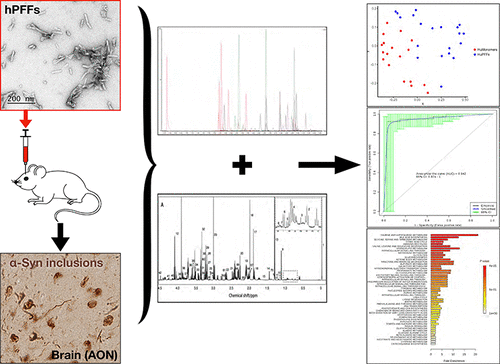当前位置:
X-MOL 学术
›
J. Proteome Res.
›
论文详情
Our official English website, www.x-mol.net, welcomes your feedback! (Note: you will need to create a separate account there.)
Biochemical Profiling of the Brain and Blood Metabolome in a Mouse Model of Prodromal Parkinson’s Disease Reveals Distinct Metabolic Profiles
Journal of Proteome Research ( IF 4.4 ) Pub Date : 2018-05-25 , DOI: 10.1021/acs.jproteome.8b00224 Stewart F. Graham 1, 2 , Nolwen L. Rey 3 , Ali Yilmaz 1 , Praveen Kumar 1 , Zachary Madaj 4 , Michael Maddens 1, 2 , Ray O. Bahado-Singh 1, 2 , Katelyn Becker 3 , Emily Schulz 3 , Lindsay K. Meyerdirk 3 , Jennifer A. Steiner 3 , Jiyan Ma 3 , Patrik Brundin 3
Journal of Proteome Research ( IF 4.4 ) Pub Date : 2018-05-25 , DOI: 10.1021/acs.jproteome.8b00224 Stewart F. Graham 1, 2 , Nolwen L. Rey 3 , Ali Yilmaz 1 , Praveen Kumar 1 , Zachary Madaj 4 , Michael Maddens 1, 2 , Ray O. Bahado-Singh 1, 2 , Katelyn Becker 3 , Emily Schulz 3 , Lindsay K. Meyerdirk 3 , Jennifer A. Steiner 3 , Jiyan Ma 3 , Patrik Brundin 3
Affiliation

|
Parkinson’s disease is the second most common neurodegenerative disease. In the vast majority of cases the origin is not genetic and the cause is not well understood, although progressive accumulation of α-synuclein aggregates appears central to the pathogenesis. Currently, treatments that slow disease progression are lacking, and there are no robust biomarkers that can facilitate the development of such treatments or act as aids in early diagnosis. Therefore, we have defined metabolomic changes in the brain and serum in an animal model of prodromal Parkinson’s disease. We biochemically profiled the brain tissue and serum in a mouse model with progressive synucleinopathy propagation in the brain triggered by unilateral injection of preformed α-synuclein fibrils in the olfactory bulb. In total, we accurately identified and quantified 71 metabolites in the brain and 182 in serum using 1H NMR and targeted mass spectrometry, respectively. Using multivariate analysis, we accurately identified which metabolites explain the most variation between cases and controls. Using pathway enrichment analysis, we highlight significantly perturbed biochemical pathways in the brain and correlate these with the progression of the disease. Furthermore, we identified the top six discriminatory metabolites and were able to develop a model capable of identifying animals with the pathology from healthy controls with high accuracy (AUC (95% CI) = 0.861 (0.755–0.968)). Our study highlights the utility of metabolomics in identifying elements of Parkinson’s disease pathogenesis and for the development of early diagnostic biomarkers of the disease.
中文翻译:

在前驱性帕金森氏病小鼠模型中脑和血液代谢组的生化分析揭示了不同的代谢谱。
帕金森氏病是第二大最常见的神经退行性疾病。在大多数情况下,尽管α-突触核蛋白聚集体的逐渐积累似乎是发病机理的中心,但其起源不是遗传的,原因也不是很清楚。当前,缺乏使疾病进展缓慢的疗法,并且没有可以促进此类疗法的发展或在早期诊断中起到辅助作用的强大的生物标志物。因此,我们在前驱性帕金森氏病动物模型中定义了大脑和血清中的代谢组学变化。我们对小鼠模型中的脑组织和血清进行了生化分析,并通过嗅球中单向注射预先形成的α-突触核蛋白原纤维触发了进行性突触核蛋白在脑中的传播。总共,1 H NMR和靶向质谱法。使用多变量分析,我们准确地确定了哪些代谢物解释了病例与对照之间的差异最大。使用途径富集分析,我们突出显示了大脑中明显受干扰的生化途径,并将其与疾病进展相关联。此外,我们鉴定出了前六种具有歧视性的代谢产物,并能够建立一个能够从健康对照中以高准确度鉴定出具有病理学特征的动物的模型(AUC(95%CI)= 0.861(0.755-0.968))。我们的研究突出了代谢组学在确定帕金森氏病发病机理的要素以及开发该病早期诊断生物标志物方面的实用性。
更新日期:2018-05-25
中文翻译:

在前驱性帕金森氏病小鼠模型中脑和血液代谢组的生化分析揭示了不同的代谢谱。
帕金森氏病是第二大最常见的神经退行性疾病。在大多数情况下,尽管α-突触核蛋白聚集体的逐渐积累似乎是发病机理的中心,但其起源不是遗传的,原因也不是很清楚。当前,缺乏使疾病进展缓慢的疗法,并且没有可以促进此类疗法的发展或在早期诊断中起到辅助作用的强大的生物标志物。因此,我们在前驱性帕金森氏病动物模型中定义了大脑和血清中的代谢组学变化。我们对小鼠模型中的脑组织和血清进行了生化分析,并通过嗅球中单向注射预先形成的α-突触核蛋白原纤维触发了进行性突触核蛋白在脑中的传播。总共,1 H NMR和靶向质谱法。使用多变量分析,我们准确地确定了哪些代谢物解释了病例与对照之间的差异最大。使用途径富集分析,我们突出显示了大脑中明显受干扰的生化途径,并将其与疾病进展相关联。此外,我们鉴定出了前六种具有歧视性的代谢产物,并能够建立一个能够从健康对照中以高准确度鉴定出具有病理学特征的动物的模型(AUC(95%CI)= 0.861(0.755-0.968))。我们的研究突出了代谢组学在确定帕金森氏病发病机理的要素以及开发该病早期诊断生物标志物方面的实用性。


























 京公网安备 11010802027423号
京公网安备 11010802027423号